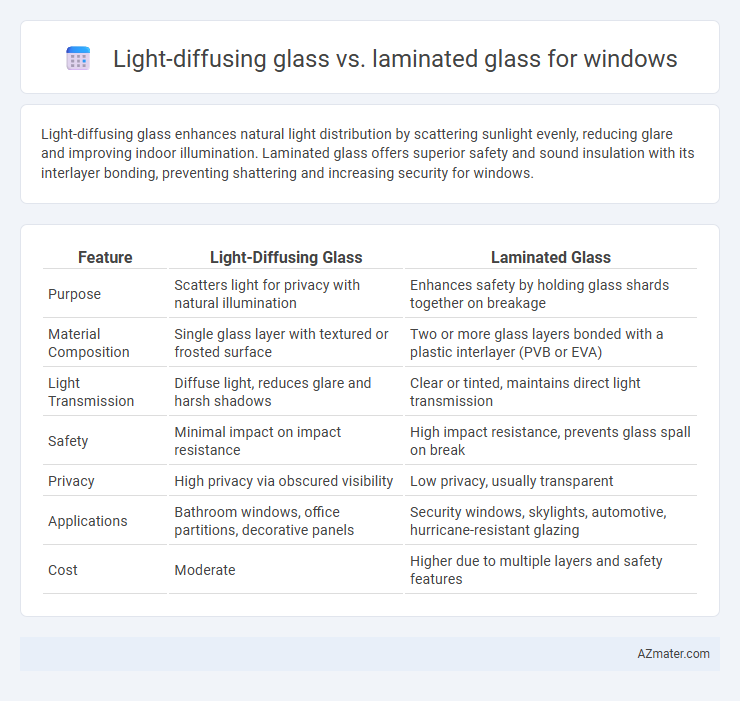Light-diffusing glass enhances natural light distribution by scattering sunlight evenly, reducing glare and improving indoor illumination. Laminated glass offers superior safety and sound insulation with its interlayer bonding, preventing shattering and increasing security for windows.
Table of Comparison
| Feature | Light-Diffusing Glass | Laminated Glass |
|---|---|---|
| Purpose | Scatters light for privacy with natural illumination | Enhances safety by holding glass shards together on breakage |
| Material Composition | Single glass layer with textured or frosted surface | Two or more glass layers bonded with a plastic interlayer (PVB or EVA) |
| Light Transmission | Diffuse light, reduces glare and harsh shadows | Clear or tinted, maintains direct light transmission |
| Safety | Minimal impact on impact resistance | High impact resistance, prevents glass spall on break |
| Privacy | High privacy via obscured visibility | Low privacy, usually transparent |
| Applications | Bathroom windows, office partitions, decorative panels | Security windows, skylights, automotive, hurricane-resistant glazing |
| Cost | Moderate | Higher due to multiple layers and safety features |
Introduction to Light-Diffusing and Laminated Glass
Light-diffusing glass is engineered to scatter incoming light, reducing glare and enhancing privacy while maintaining natural illumination in spaces. Laminated glass consists of two or more glass layers bonded with a plastic interlayer, providing increased safety by holding shards together upon impact and offering sound insulation. Both materials are commonly used in window applications to balance light management, safety, and aesthetic appeal.
Key Differences Between Light-Diffusing and Laminated Glass
Light-diffusing glass evenly scatters incoming light to reduce glare while maintaining natural illumination, ideal for enhancing indoor lighting quality. Laminated glass consists of multiple glass layers bonded with a plastic interlayer, providing superior safety, sound insulation, and UV protection. The key difference lies in light management versus structural safety: light-diffusing glass optimizes visual comfort, whereas laminated glass prioritizes impact resistance and security.
How Light-Diffusing Glass Works in Windows
Light-diffusing glass incorporates microscopic patterns or additives that scatter incoming sunlight, creating a soft, even distribution of light throughout the room while reducing glare. Unlike laminated glass, which consists of layers bonded with an interlayer for strength and safety, light-diffusing glass specifically enhances natural lighting quality by diffusing direct sunlight and preventing harsh shadows. This glass type is ideal for windows in spaces requiring balanced illumination without sacrificing privacy or natural light intensity.
Laminated Glass: Structure and Functionality
Laminated glass consists of two or more glass layers bonded with an interlayer, typically polyvinyl butyral (PVB), enhancing safety by holding shards together upon impact. Its structure provides superior sound insulation, UV protection, and increased security compared to light-diffusing glass, making it ideal for windows requiring both durability and performance. Laminated glass also offers improved resistance to weathering and can be customized for varying levels of transparency and tinting.
Aesthetic Impact of Light-Diffusing vs Laminated Glass
Light-diffusing glass enhances interior spaces by scattering natural light evenly, reducing glare and shadows while creating a soft, ambient glow that elevates aesthetic appeal. Laminated glass offers a sleek, clear appearance with structural benefits, maintaining maximum transparency and visibility but without the unique light-scattering effects of diffusing glass. Choosing between the two depends on whether the priority is on artistic light transformation or maintaining crisp, uninterrupted views with safety.
Energy Efficiency and UV Protection
Light-diffusing glass enhances energy efficiency by dispersing natural light evenly, reducing the need for artificial lighting and lowering cooling costs through minimized heat gain. Laminated glass provides superior UV protection by incorporating an interlayer that blocks up to 99% of harmful ultraviolet rays, preventing interior fading and improving occupant health. Combining light diffusion with laminated UV-blocking technology offers an optimal window solution for energy savings and long-term interior preservation.
Safety and Security Considerations
Light-diffusing glass enhances privacy by scattering light while maintaining visibility, but its laminated counterpart offers superior safety through a robust interlayer that holds shattered pieces together, reducing injury risks. Laminated glass excels in security, providing strong resistance against forced entry and impact, whereas light-diffusing glass primarily addresses aesthetic and privacy needs without significantly boosting physical protection. Choosing laminated glass for windows ensures enhanced occupant safety and increased burglary deterrence, making it preferred for high-security environments.
Maintenance and Durability Comparison
Light-diffusing glass typically requires less maintenance due to its ability to evenly distribute light, reducing the visibility of dirt and smudges, while laminated glass may demand more frequent cleaning to maintain clarity. In terms of durability, laminated glass excels with its interlayer that holds shards in place upon impact, enhancing safety and resistance to breakage, whereas light-diffusing glass focuses on aesthetic diffusion but can be more prone to surface damage though still robust. Choosing between the two depends on the priority of maintenance ease versus enhanced protective features for window applications.
Cost Analysis: Upfront and Long-Term Investment
Light-diffusing glass typically has a higher upfront cost due to specialized manufacturing processes compared to laminated glass, which is more affordable initially and widely available. Long-term investment in light-diffusing glass often proves beneficial by reducing energy costs through enhanced natural light distribution and improved glare control. Laminated glass offers strong safety benefits and UV protection but may incur higher replacement costs due to its susceptibility to delamination over time.
Choosing the Right Glass for Your Window Needs
Light-diffusing glass enhances natural illumination by scattering sunlight evenly across a room, ideal for reducing glare and creating a soft, comfortable atmosphere in residential or office spaces. Laminated glass, composed of two or more glass layers bonded with an interlayer, prioritizes safety, sound insulation, and UV protection, making it suitable for windows requiring impact resistance and security. Selecting between these types depends on your primary needs: choose light-diffusing glass for aesthetic and lighting benefits, while laminated glass suits applications demanding durability and enhanced protection.

Infographic: Light-diffusing glass vs Laminated glass for Window
 azmater.com
azmater.com